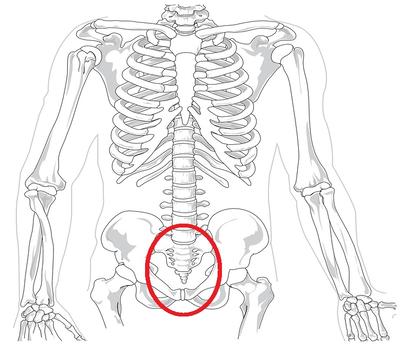Coccydynia, or pain in the tailbone, may make even simple tasks difficult to bear. Sitting may be excruciatingly painful if the coccyx, a little triangular bone at the base of the spinal column, has been injured in any way (bruised, fractured, or dislocated). Pain may be reduced with over-the-counter medications and lifestyle adjustments including decreasing sitting time and switching to chairs with more padding. Pain in the tailbone might be the result of a fall, delivery-related trauma, or prolonged sitting on a narrow or hard surface. Remarkably, one-third of those who get tailbone discomfort don’t know what causes it.
Understanding the Coccyx and its Role in Tailbone Pain
The coccyx, a triangle bone at the base of the spinal column, is a major contributor to this kind of discomfort. Accidents like falling, sitting for too long, or even giving birth may cause it to become bruised, fractured, or dislocated. The structure of the coccyx, which comprises three to five fused vertebrae, tendons, muscles, and ligaments, must be understood in order to appreciate its function. Pain in the tailbone may be alleviated with over-the-counter medications, pressure-reduction cushions, heat or ice, and lifestyle adjustments. Physical therapy, muscular massages, local anesthetic injections, and surgery are all possibilities for those with chronic coccydynia who have tried less invasive methods without success.
Causes of tailbone pain
Trauma or arthritis-related joint abnormalities are two potential causes of tailbone discomfort. Both falls and prolonged sitting on hard surfaces may cause serious injuries. The tissues surrounding the coccyx may also be strained by sports that include spinal stretching. Changes to the joints may occur during labor and delivery due to the release of hormones that relax the ligaments connecting the sacrum and the coccyx. These modifications permit painful coccyx motion. Pain in the tailbone is another symptom of arthritis, which causes discomfort due to joint abnormalities.
Tailbone pain in pregnancy and childbirth
Pregnant women often experience severe discomfort in their tailbones due to pregnancy and labor. Hormonal shifts during pregnancy may cause ligaments and muscles in the pelvis to relax, which can cause discomfort. This shift results in more intense contractions, which in turn produce discomfort at the tailbone. Keeping up with good posture during pregnancy is the best way to ease this pain. The most efficient methods of relieving pain include walking around often, sitting up straight, and sleeping with a cushion between the legs. If discomfort continues, see a doctor and try using a special pillow or cushion to take the weight off your tailbone.
Medical Treatments
Patients may find comfort by using a pressure-reduction cushion while seated or by applying heat or cold to the afflicted region. Painkillers like acetaminophen and ibuprofen may also be taken. If your tailbone discomfort persists after self-care, see a doctor. Treatment options may include coccyx removal surgery, massage therapy, injections, or physiotherapy.
Physical therapy and pelvic floor techniques
- Injury, extended sitting on a hard surface, joint changes due to arthritis, and even delivery are all potential triggers for coccydynia, the medical term for tailbone discomfort. The majority of people make a complete recovery from tailbone pain within a few weeks or months. Nonetheless, medical intervention may be necessary for those with persistent coccydynia.
- Pain in the back of the thigh or tailbone? Physical therapy may assist. Pelvic floor relaxation methods, such as deep breathing, may be taught by a physical therapist to help calm the muscles around the tailbone. Pain may also be reduced by rubbing the afflicted region and moving the muscles through the rectum.
- A pressure-relieving cushion may be used instead of a standard seat cushion. To alleviate discomfort, wedge-shaped cushions are frequently the best choice. Using heat or ice or taking an over-the-counter pain treatment like acetaminophen or ibuprofen may help. If the pain in your tailbone continues after these treatments, you should see a doctor, who may order imaging tests like a rectal exam or an MRI. Coccyx removal surgery may be required in very unusual circumstances.
Injections and Surgery for Severe Tailbone Pain
Aching in the tailbone is a common complaint. Chronic pain in the tailbone is quite uncomfortable, but it often goes away within a few weeks or months. Injections of corticosteroids or physical therapy may be helpful in such circumstances. Nevertheless, if non-invasive methods fail, surgical intervention may be suggested. The whole coccyx is removed during a procedure called a coccygectomy. General or regional anesthesia may be used for the surgery, and a hospital stay of one night is typical thereafter. Patients may need to limit their sitting and driving for the first several weeks after surgery, and recovery may take anywhere from four to eight weeks.
At-Home Remedies for Tailbone Pain Relief
One of the most helpful treatments for tailbone pain is heat or ice. To lessen inflammation and speed recovery, try alternating hot and cold packs, taking hot baths, or using heating pads. To lessen discomfort when seated and release pressure on the lower back, specialized exercises may promote spinal mobility and stretch the muscles in the buttocks and hips. Coccydynia pillows are another option for pain relief and harm prevention. Talk to a specialist in spine pain management about options like physical therapy or corticosteroid injections if you’re experiencing ongoing discomfort in your tailbone.
About the Author
Reyus Mammadli is the author of this health blog since 2008. With a background in medical and biotechnical devices, he has over 15 years of experience working with medical literature and expert guidelines from WHO, CDC, Mayo Clinic, and others. His goal is to present clear, accurate health information for everyday readers — not as a substitute for medical advice.







